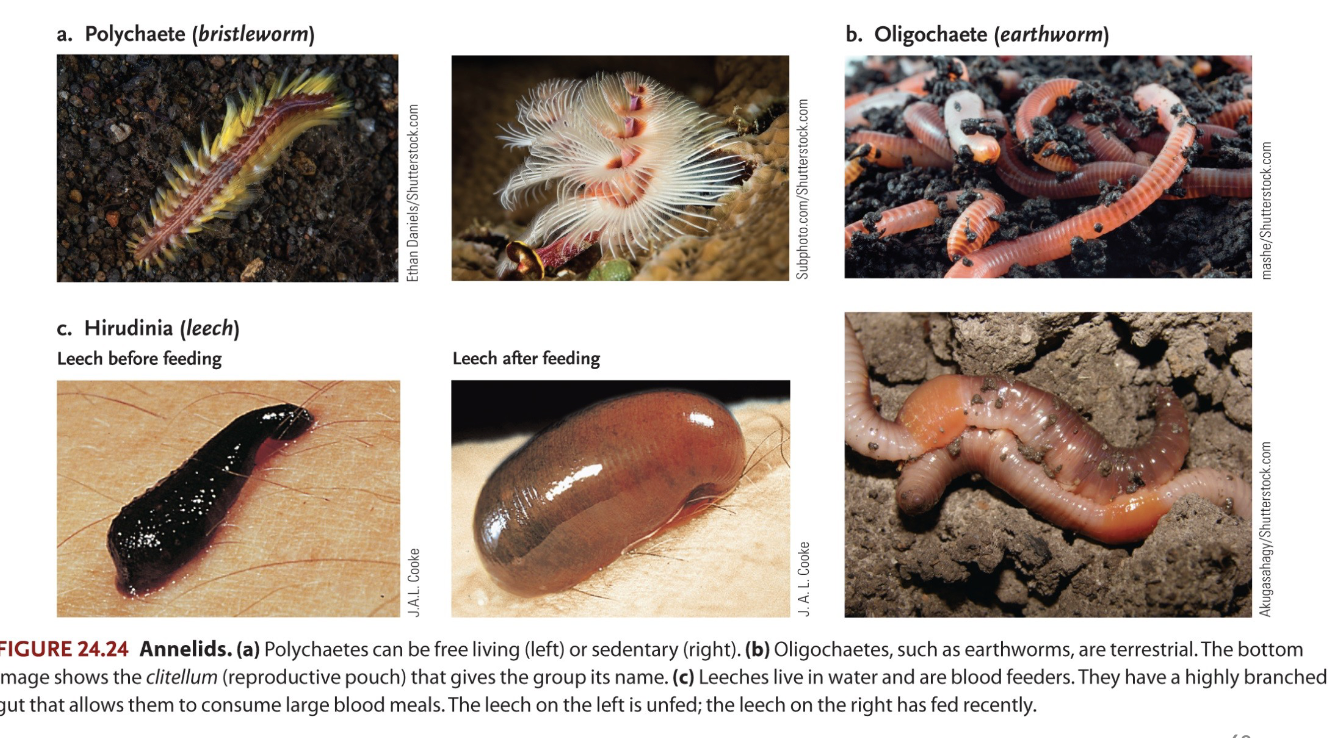BIOL 371 MIDTERM 1
1/191
Earn XP
Name | Mastery | Learn | Test | Matching | Spaced |
|---|
No study sessions yet.
192 Terms
THEME 1
What is an organism (2)?
The living world can be organized hierarchically - organism is one level in this hierarchy
An organism can consist of a single cell or multiple cells
Define the domains of life
The major divisions of the living world are defined by cell characteristics (morphologically look similar, which is why it comes down to a cellular basis)
What are the 3 domains of life?
Bacteria, Archaea, Eukarya
Lateral transfer was an important route for ___
The acquisition of evolutionary novelties
Major Characteristics of a Eukaryote (7)
1) Cytoskeleton
2) Endomembrane system
3) Primary genome of multiple linear chromosomes
4) 80s ribosomes
5) Mitochondria
6) Plastids (in algae/plants)
7) Sexual reproduction
Provides diversity through gametes & fusion of gametes
Cytoskeleton Importance (3)
Protein fiber networks support plasma membrane and organelles within cytoplasm
Allows movement of organelles within the cell and maintenance of their spatial relationships
Allows cell to control its shape, and move
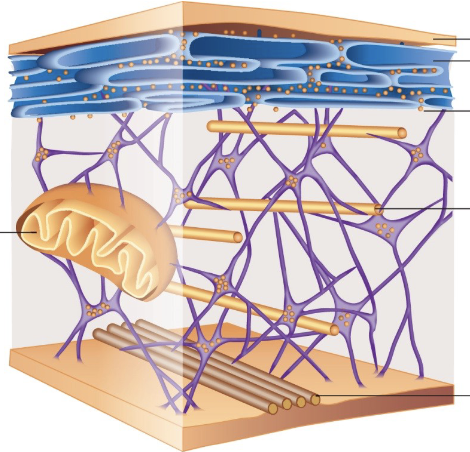
Components of Cytoskeleton (7)
*Purple interconnections are intermediate filament
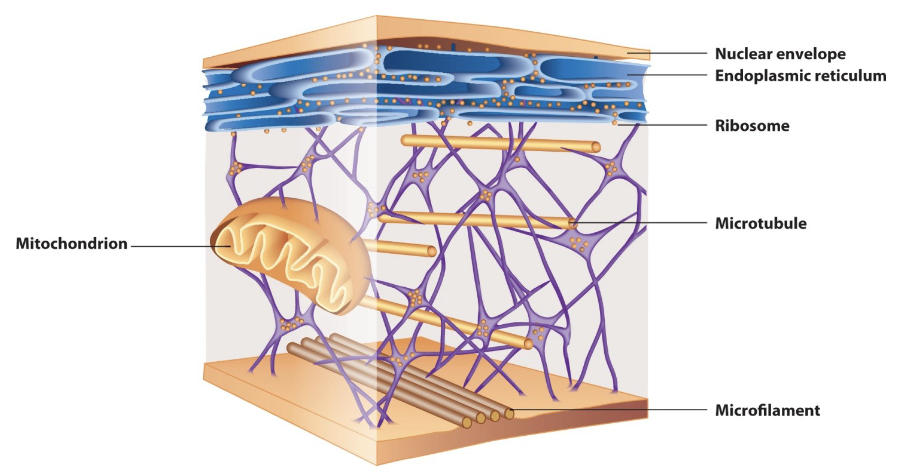
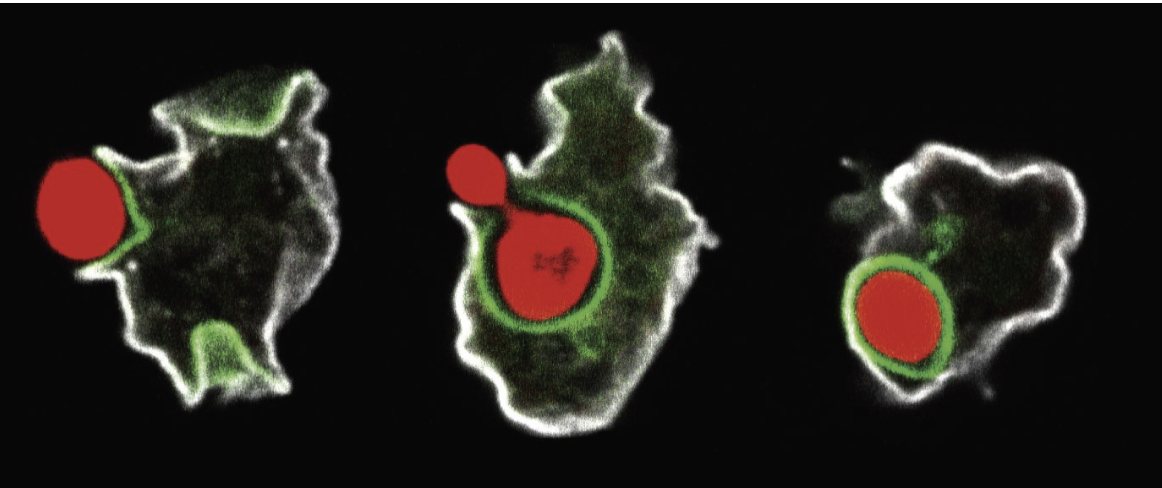
Continuation of Cytoskeleton Importance
Enables eukaryote cell to engulf food particles (phagocytosis)
Microtubule (Composition & Function)
Hollow tube formed from tubulin dimers
Thirteen tubulin dimers side by side in a microtubule
Two types of tubulin dimers: α-tubules & β-tubules
Polar: α-tubules (-) compose one end and grow slowly & β-tubules (+) compose the other end and grow quickly
Organize the position of organelles, direct intracellular transport, & support the shape of the cell by resisting compression
Molecules (like vesicles) grab them and move on them like railway tracks
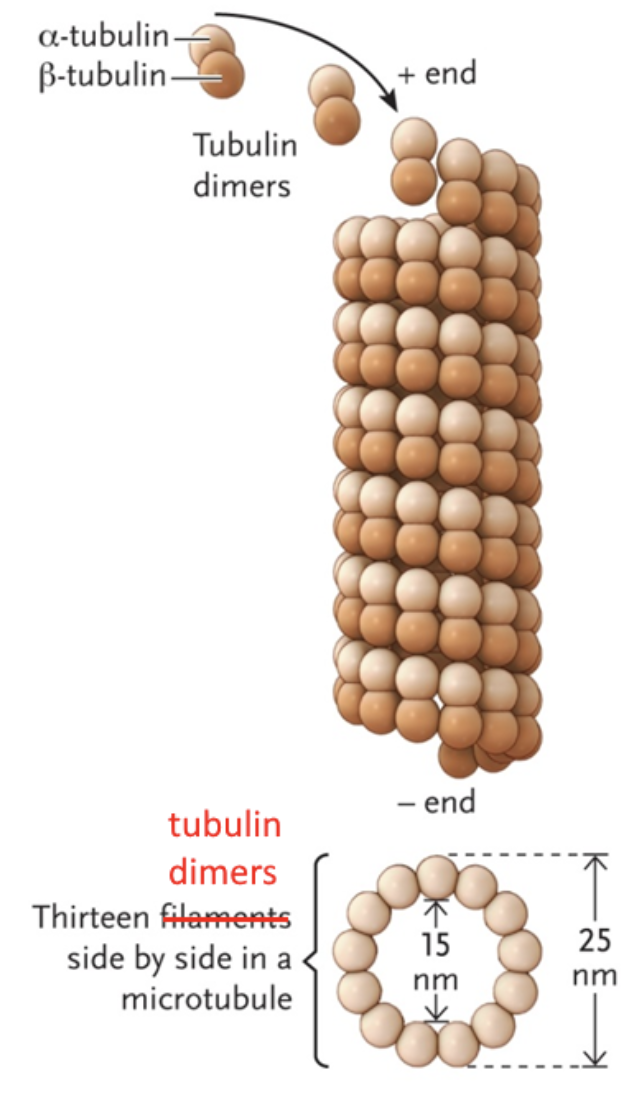
Intermediate Filament (Composition & Function)
An intermediate filament is a strong fiber composed of intermediate filament proteins
Build cable networks connecting the cells of epithelial sheets, and provide mechanical strength (resist tension) that allows the cell to maintain its shape
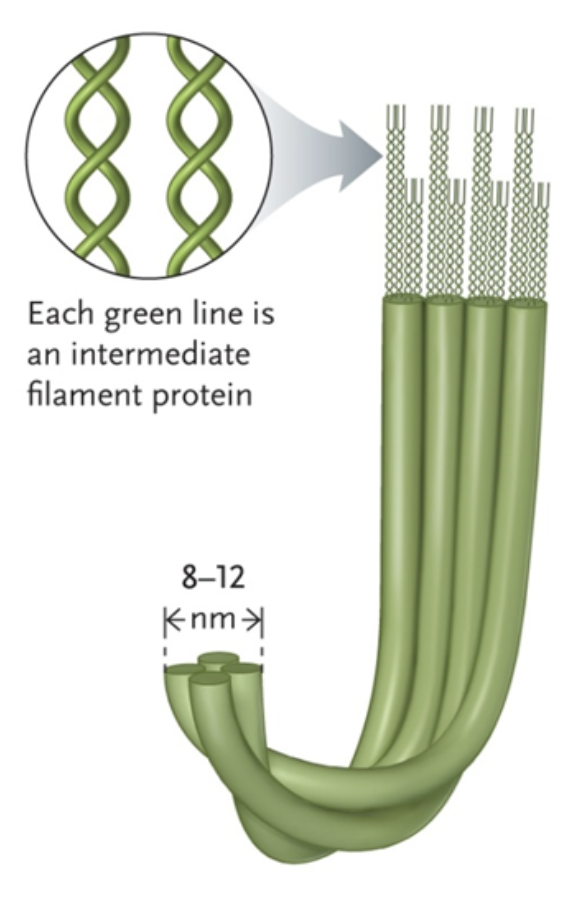
Microfilament (Composition & Function)
A double helix of actin monomers
Important in movement (site for myosin to grab onto and move), and intracellular transport

What are the cytoskeletal elements that allow cells to move or create currents? (2)
Cilia & Flagella
Cilia & Flagella (Composition, Function, & Examples)
Composition (same for both): Ring of microtubules wrapped in a membrane
Function (Flagella): Whip back and forth to propel a cell through liquid (propeller like motion)
Example:
Sperm Cells - Swim by movement of the flagellum
Function (Cilia): Wave back & forth (like rowers)
Example:
Cilia of a Paramecium - Coordinated beating of the cilia that cover the paramecium moves the cell through its environment
Cilia in human airways - Cilia on the epithelial cells of the airway propel mucus containing debris out of the lungs
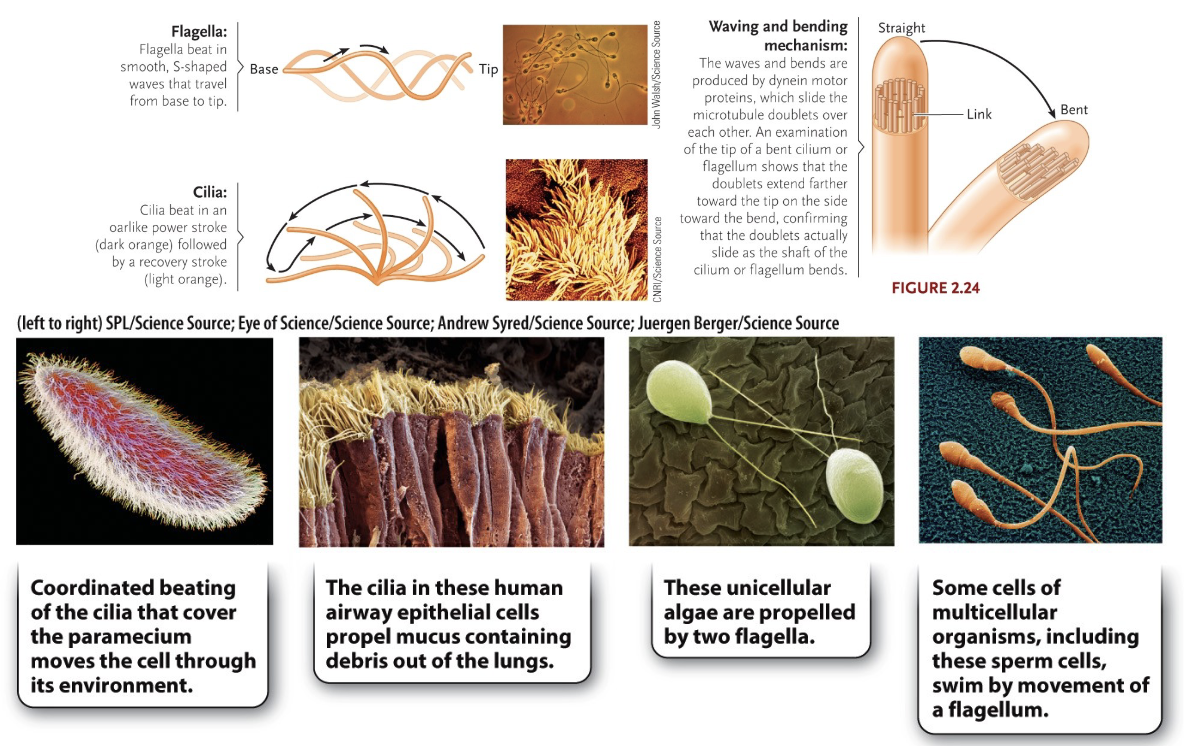
Eukaryote Endomembrane System (2)
Definition + 5 Major Components
Collective term for nuclear envelope, lysosomes, Golgi apparatus, vacuoles, endoplasmic reticulum
Definition: Series of flattened sacs and tubes formed of lipid bilayer membranes, directly interconnected or connected by moving vesicles
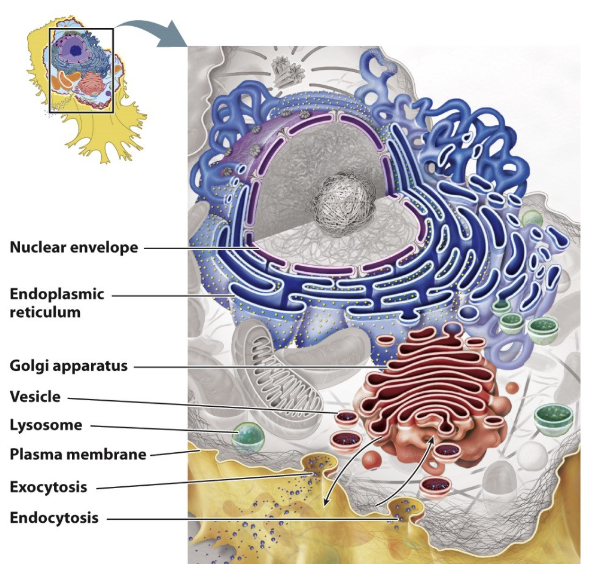
General Function of the Eukaryote Endomembrane System
To compartmentalize the interior of the cell to greatly increase available surface area for synthesis
This is done by isolating incompatible biochemical processes, and transferring products between these compartments
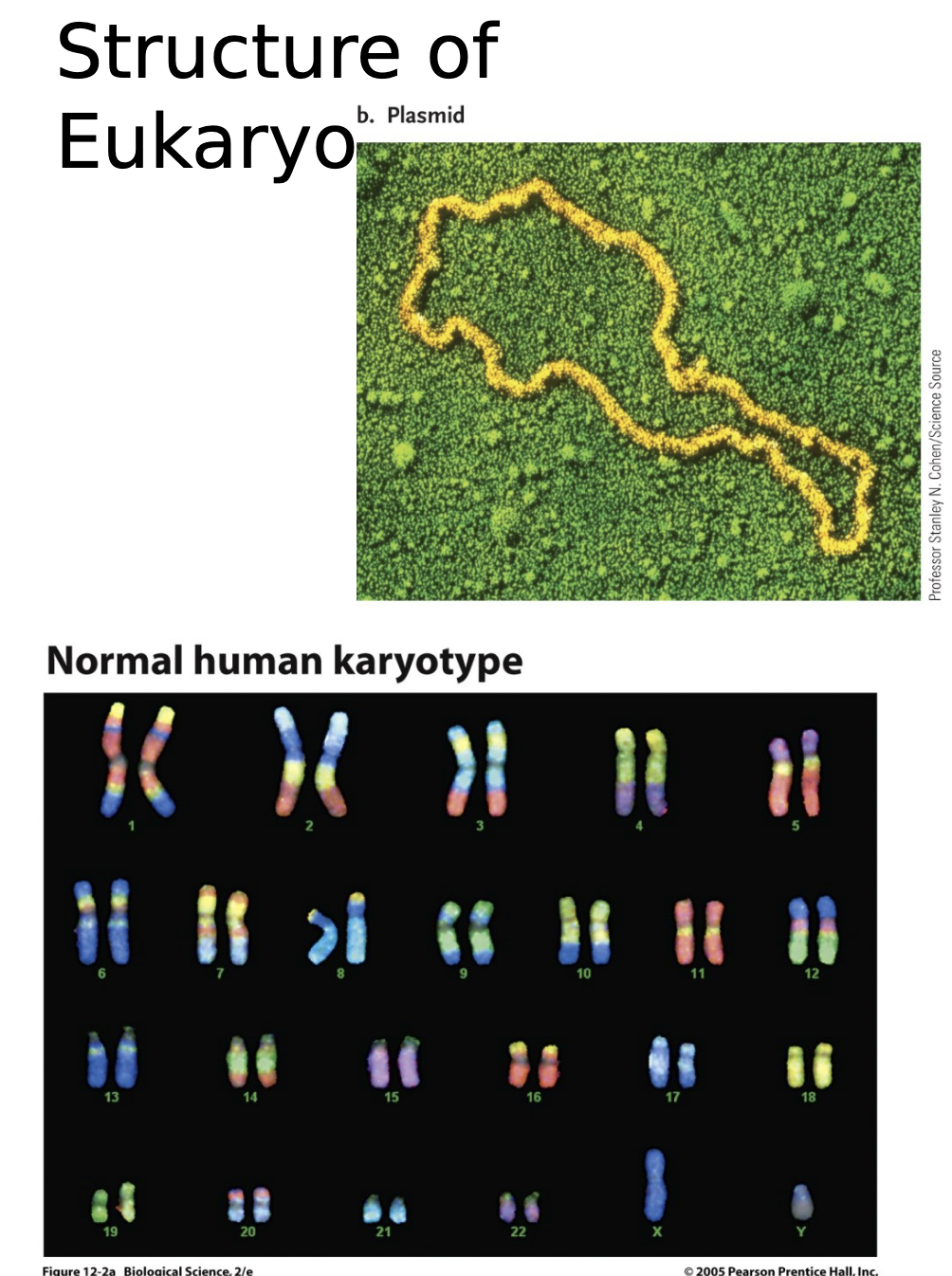
Structure of Eukaryote (3) vs. Prokaryote Genome (2)
Prokaryote genome is a single loop of DNA
Good for rapid replication, but gene regulation must be simple (everything is on the same structure)
Eukaryote genome divided between a number of linear chromosomes
Allows for complex gene regulation
Allows cell differentiation and the production of different tissue types
Chromosome replication can take place in parallel
Mitochondria & Chloroplasts (2 + Definitions)
Neither of these is found in prokaryote cells, although there are prokaryotes that engage in oxidative phosphorylation and photosynthesis
Both greatly increase surface area available for these processes when compared to prokaryotes
Folded up areas in a small volume
Mitochondria: Site of oxidative phosphorylation in eukaryote cells
Chloroplasts: Site of photosynthesis in eukaryote cells
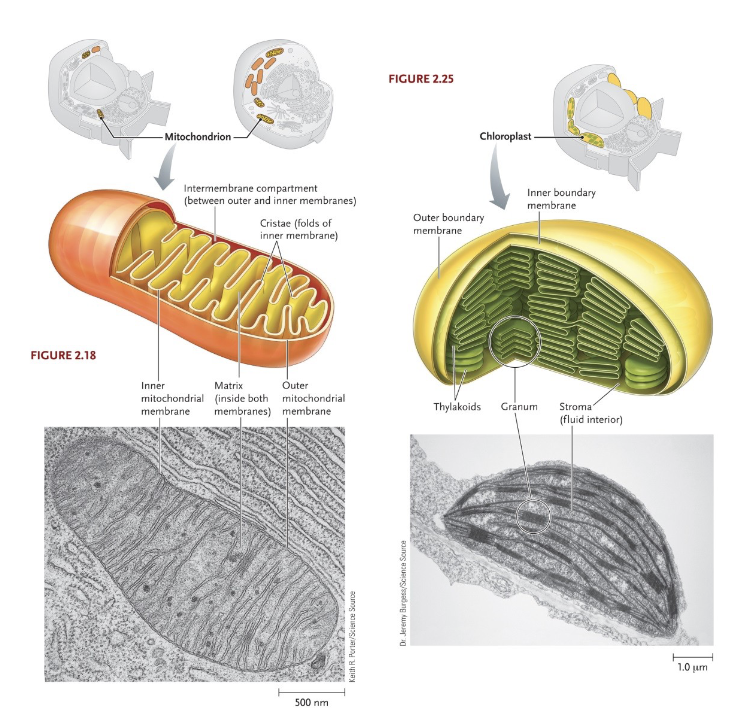
Sexual Reproduction (2)
The fusion of two haploid gametes from two parents to form a new individual genetically different from either parent (vertical transmission)
Generates genetic diversity through independent assortment and recombination
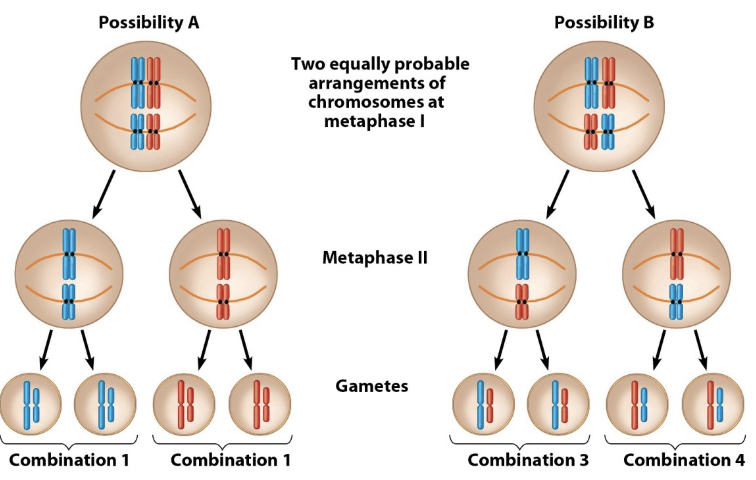
Evidence For The Endosymbiotic Origins of Mitochondria & Plastids (6)
Circular DNA
Independent Fission: Remove mitochondria or plastids from a eukaryotic cell and it cannot produce new ones
Size (1-10µm: bacteria sized)
Double membrane
Certain proteins specific to bacteria cell membrane are also in mito/chloro membranes
70s ribosomes
Primary Endosymbiotic Hypothesis (Part 1 & 2)
Heterotrophic eukaryotes evolved through union of ancestral archaean with aerobic α-proteobacterium, which became mitochondrion
Autotrophic eukaryotes evolved from heterotrophic eukaryotes through union with photosynthetic cyanobacterium, which became chloroplasts
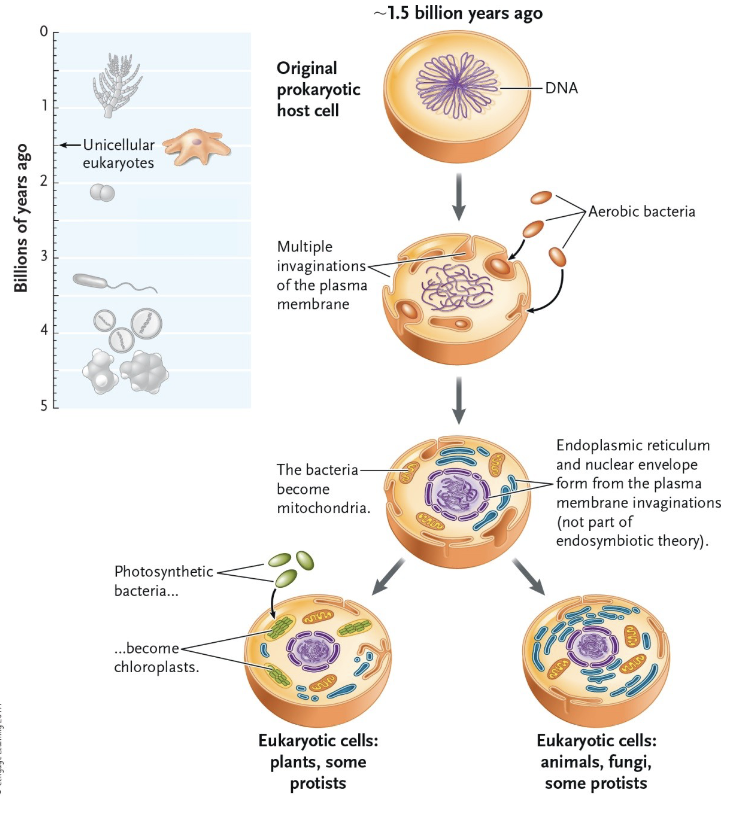
The acquisition of mitochondria and plastids by primary endosymbiosis is a form of __
Lateral transfer
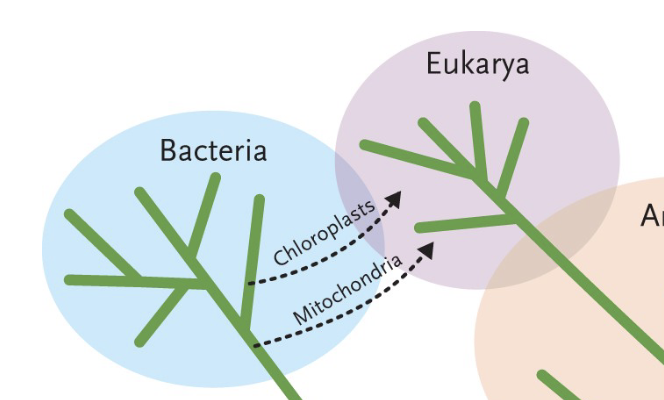
The two alternative scenarios for evolution of the final form of heterotrophic eukaryote cells:
Hypothesis 1) Ancestral archaean first evolved endomembrane system, then entered symbiosis with α-proteobacterium, which became mitochondrion
Hypothesis 2) Primary Endosymbiotic Theory Part 1
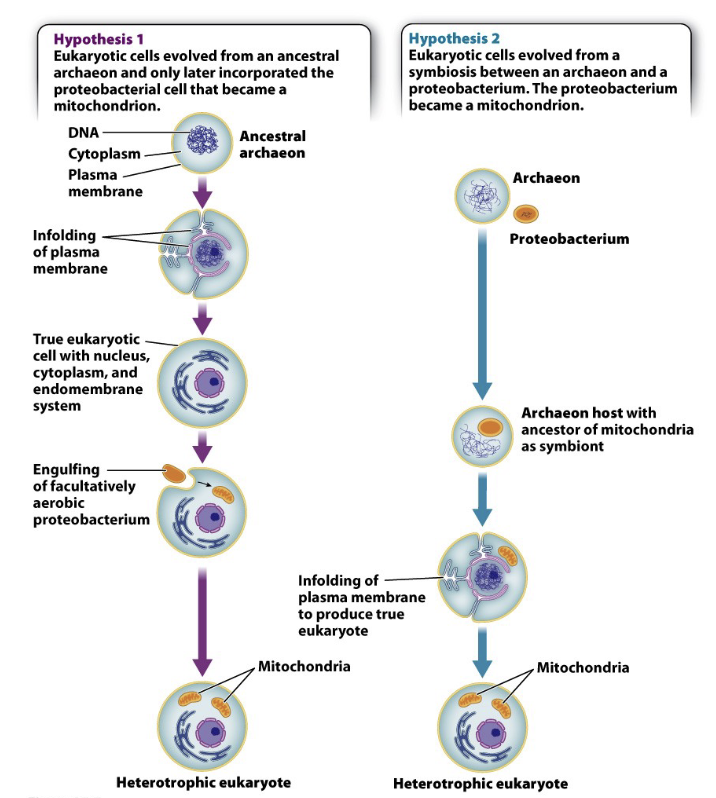
An All-At-Once Model (5)
The endosymbiotic event that produced the mitochondria also produced the endomembrane system
Archaea can’t engage in phagocytosis (cell wall)
Outgrowth of archaean cell wall around adjacent symbiotic α-proteobacterium enclose them - they became mitochondria
Archaean cell membrane becomes endomembrane system
Alternatively, endomembrane system could arise from mitochondria vacuoles
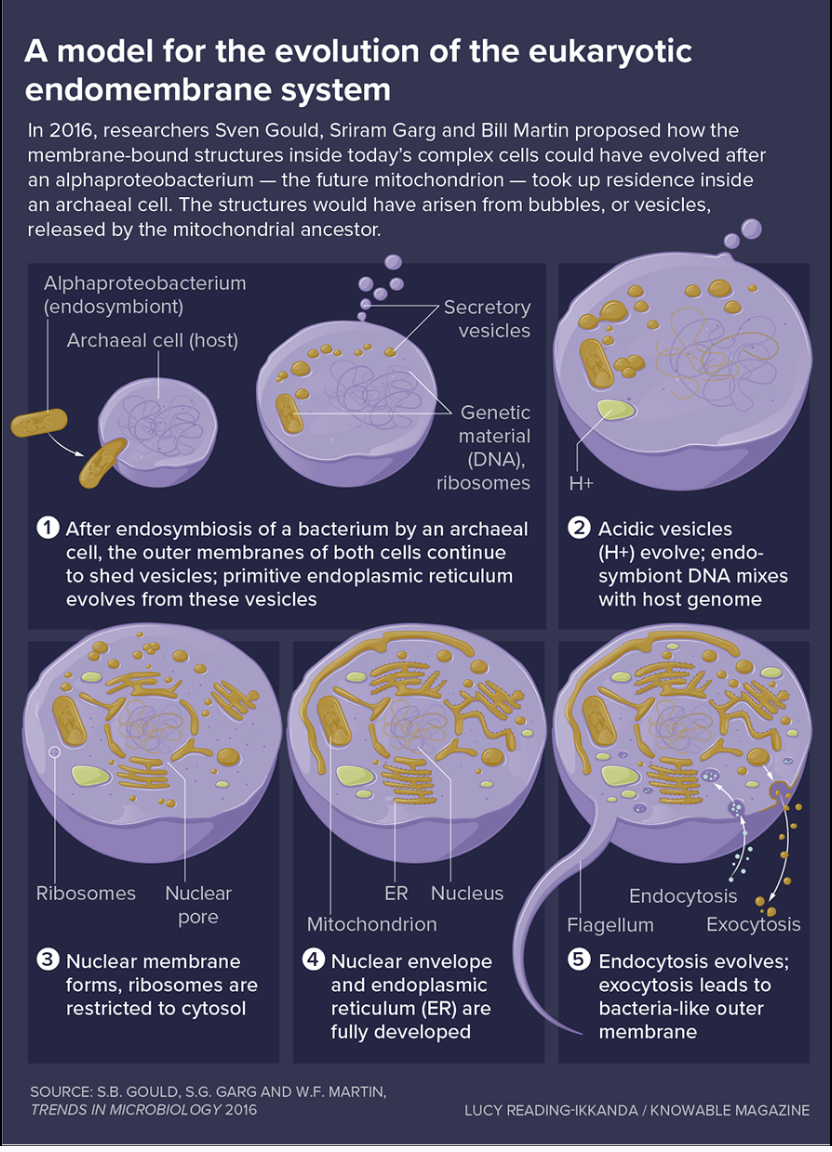
Prokaryote ___ transferred to eukaryote ___
Genes
Nucleus
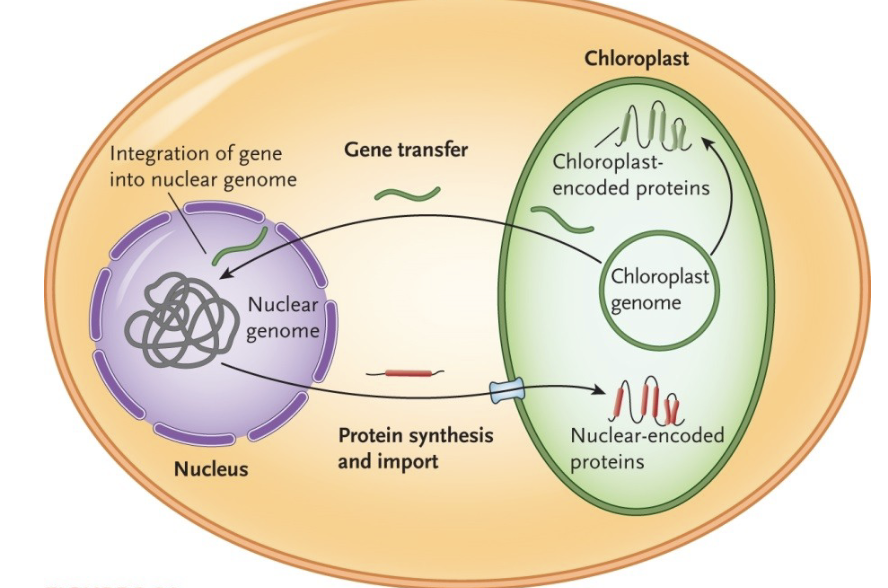
Secondary Endosymbiosis
Major eukaryote taxa arose as a result of symbiosis of heterotrophic eukaryote cell with an autotrophic eukaryotic cell
3 Independent occurences
This process allowed photosynthesis to appear in lineages that did not initially possess primary chloroplasts
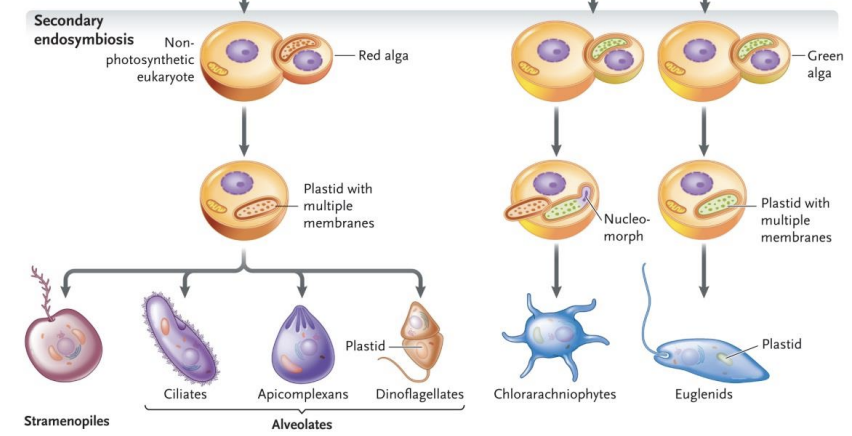
Cell Sizes
Cells are small - most have diameters in the 1-100µm range)
Eukaryotic cells are generally much larger than prokaryotic cells
Surface Area/Volume Relationships - Cells
Cube-Square Relationship: Surface area & volume of a solid do not increase linearly with an increase in linear dimensions
Surface area is proportional to (length)2
Volume is proportional to (length)3
Surface area is proportional to (volume)2/3
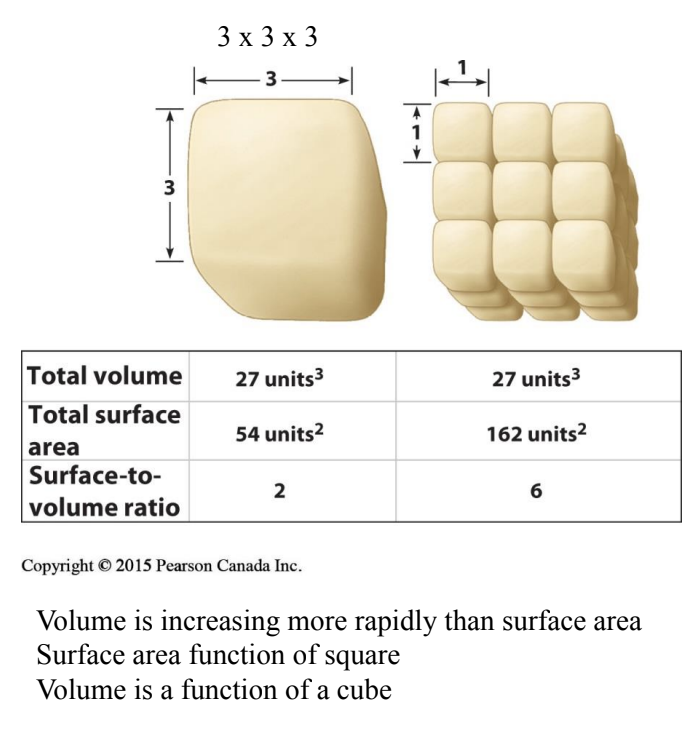
Define Constraining Relationship
Exchange across membranes around or within a cell is by diffusion or active transport (both only work effectively over very short distances & rates are dependent on surface area)
Critical limiting relationship in biology (this is why cells are small)
Cube-Square Relationship
The rates at which all materials enter and exit the cell are a function of its ___
Surface Area
The rate at which gasses and nutrients are used and wastes produced are a function of the cell’s ___
Volume
Small cells exchange materials ___ with their environment than large ones
More effectively
To big of a cell will choke on it’s own waste and die
Endomembrane systems and increased internal surface areas of chloroplasts & mitochondria involve ___, allowing ___
Elaborate folding of extensive membranes
More scope for membrane-associated processes
Allows eukaryotic cells to produce more energy & have greater synthetic scope (they can be bigger and more energetic than prokaryotic cells)
This happens because more function of the ETC on the membrane allowing more energy overall to be produced (and more area for photosynthesis for chloroplasts)
Types of Multicellularity (2)
1) Simple Multicellularity
2) Complex Multicellularity
Simple Multicellularity (3)
Cell adhesion, cell-cell communication (less), structurally simple, no bulk flow
Most cells are in direct contact with the environment
Made up of multiple similar cells that are connected by adhesive molecules

Define Bulk Flow
Movement of fluids or gasses through channels, rather than cell-to-cell
Complex Multicellularity
Cells adhere, communicate, differentiate, and specialize (formation of tissues)
Origins of Multicellular Life (3 Theories)
1) Symbiotic Theory
Separate species came together to form a multicellular organism
2) Syncytial Theory (e.g placenta)
A single unicellular organism, with multiple nuclei, could have developed internal membrane partitions around each of its nuclei, and then specialized to form a new cell
3) Colonial Theory
Multiple cells from the same unicellular species came together and specialized to become a multicellular organism
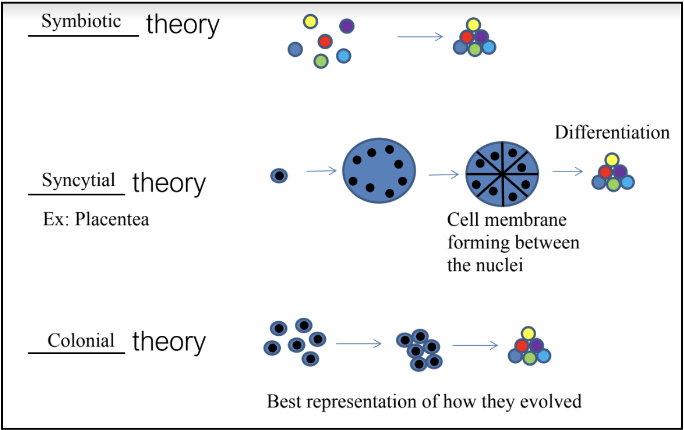
Reason For The Evolution of Multicellularity (3)
Cyanobacteria (The Great Oxygenation Event)
Rise in environmental oxygen levels due to photosynthesis advantage
Gave selective advantage to possession of mitochondria and aerobic respiration, which permitted multicellularity (excess energy)
The Rise of Multicellularity (2)
Simple multicellularity appears at the end of the Great Oxygenation Event
Complex multicellularity appears with subsequent rise in environmental O2 levels
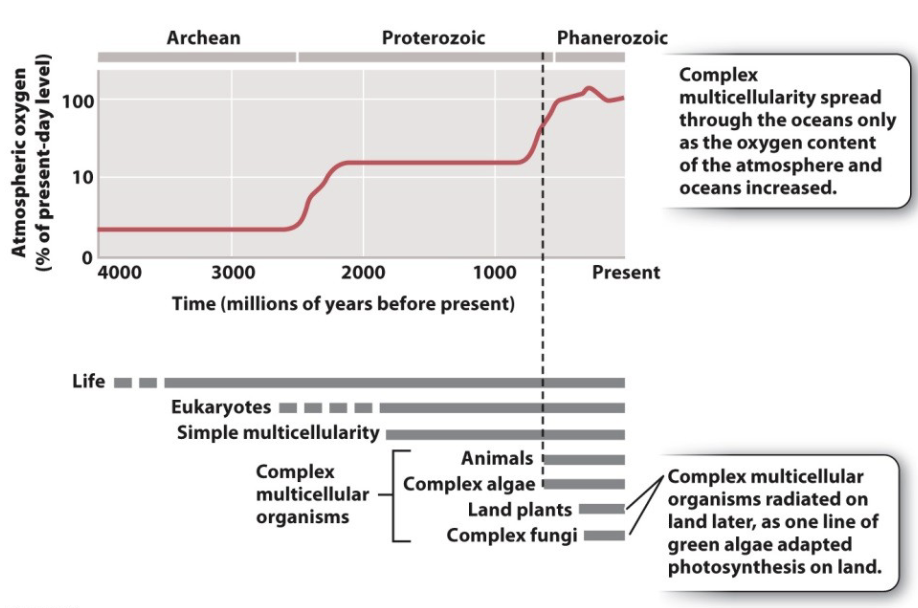
Origins of Multicellularity: Colonial Theory (5)
Most evolutionary models begin with flagellated unicellular organisms
Choanoflagellates in the case of animals
Required that cells be able to adhere to one another
Required that cells divide up tasks, specialize
Required that cells learn to communicate with one another
Affect one another’s behaviour, influence one another’s development, coordinate complex actions
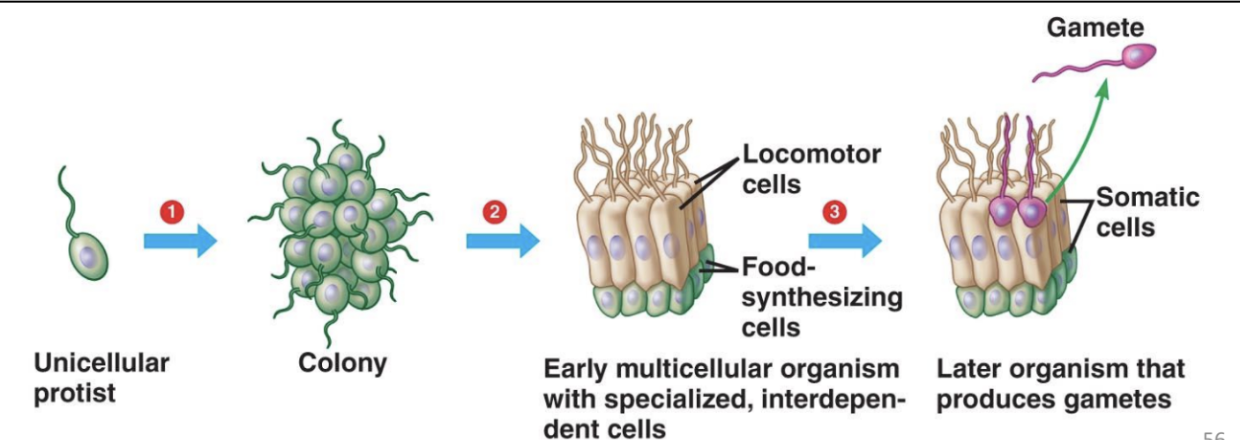
Why Multicellularity? (3)
Unicellular organisms must carry out all functions of metabolism, homeostasis, reproduction, repair etc., with the resources of a single cell
Single isolated cells must deal directly with their environment
Unicellular organisms can’t get very big (cube-square relationship keeps cells small)
Selective Advantages of Multicellularity
Division of labour and economy of scale
Bunch of cells in an environment means more effective (turned into large colonies to avoid predation & stayed large)
Increased size
Avoid predation/eat larger things
Exploit new environments (reach upwards)
Storage
Increased feeding mechanisms/opportunities
Protected internal environment that can be regulated (reduces work needed in order to maintain homeostasis)
Cells can specialize since internal environment is regulated (less expenditure of energy in order to maintain internal environment means leftover energy)
New metabolic functions (bigger size means easier to retain heat - body temperature)
Enhanced motility (self-actuated movement - expend energy to move yourself and structures to do such)
Increased traction in wind/current (smaller organisms carried away by wind and/or water)
Share information with other cells (more cells that make up the body means more elaborate communication between them - neural networks, cells for hormone secretion, etc.,)
Consequences of Multicellularity
Complexity
Predator/prey and host/parasite interactions
Increased opportunity for diversity in form/function & niches
Challenges of Multicellularity
Intercellular communication (cells must be able to communicate with one another)
Diffusion
Gap junctions/plasmodesmata
Bulk flow
Nerves
Signalling molecules
Cell Adhesion (cells in a multicellular body must stick together)
Cube-Square Relationship
Volume increases as a function of the cube of the linear dimensions with increasing size
Surface area increases as a function of the square of the linear dimensions with increasing size
As an organism gets larger, its surface area becomes smaller relative to its volume (or mass)
Exchange takes place across surfaces
Must create solutions to allow exchange and rapid transport
Structure & Support
Physical laws set absolute limits on animal size & performance
Morphology reflects accommodation with these limits, i.e. terrestrial animals can get only so big, aquatic animals require streamlining, small animals lose heat to the environment quickly, etc.,
Challenges vary over animal body size range and habitat
Animals, Size, & Physics
Size range of animals is about 12 orders of magnitude
Surface Area/Volume Relationships: Metabolic Rate & BMR
Metabolic rate in mammals is measured by organism O2 consumption
O2 consumption increases with body size
Resting elephant consumes more O2 in any given interval than resting mouse (200,000x mass difference)
Basal Metabolic Rate (BMR) (rate at which body uses energy at rest) much lower for elephant than for the mouse
The elephant has proportionally much less surface area for dissipation of heat than rabbit
With greater body size, mass-specific metabolic rate must decrease
Adaptations For Increasing Surface Area (3)
1) Gas Exchange
Gills bear lamellae, composed of flattened epithelial cells highly folded to pack greater surface area into small volume
2) Nutrient Absorption
Villi of small intestine epithelial cells increase surface area for absorption, within a small volume
3) Filtration
Body’s combined capillary beds provide extremely large cumulative surface area for exchange between blood & tissues
Challenges of Being Multicellular - Continuation
Homeostasis
Defend cells against hostile environment
Maintain stable internal environment for internal cells
E.g. The water content of a multicellular organism can be divided into two major compartments:
1) Intracellular Fluid (60%)
The intracellular fluid compartment is all of the body’s water found within cells (liquid portion of cytoplasm)
2) Extracellular Fluid (40%)
All of the body’s water not found within cell plasma membranes (Forms cells’ immediate environment: interstitial fluid, plasma, bone & dense connective tissue)
There is a lot of exchange (gasses, nutrients, waste, etc.,) between intracellular fluid & extracellular fluid, and so composition and volume of extracellular fluid must be kept stable to minimize the amount of work cells must do to maintain their own individual homeostasis
Reproduction & Growth
The multicellular body must be able to produce new multicellular bodies
Sex, fertilization, development, & growth
Development & differentiation require complex & flexible control systems
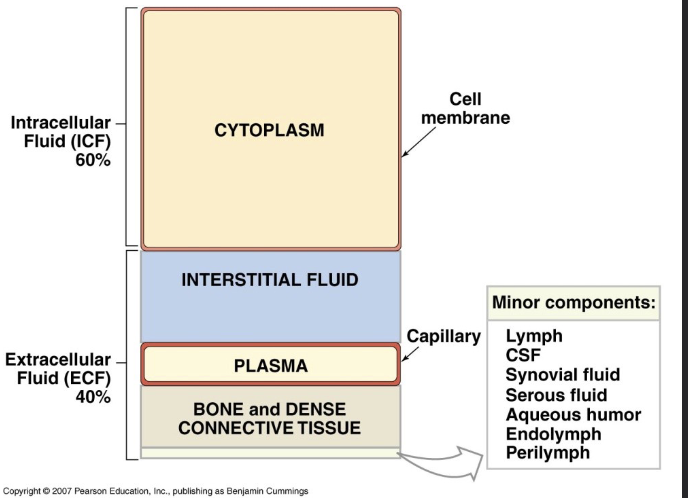
Reproduction & Growth (Unicellular vs. Multicellular)
Unicellular
Fission or mitosis (quick & easy)
Multicellular
Fusion of gametes followed by growth & differentiation
Cell Adhesion/Cell Junctions (3)
Cells in multicellular bodies must be attached to one another or to an acellular matrix
1) Tight Junctions
Penetrate cell membranes of adjacent cells, fix cells in place, prevent movement of liquids between cells
2) Anchoring Junctions
Adjacent cells link to each other and intermediate filaments or microfilaments of cytoskeleton
Provide a physical connection between cells of the body by reinforcing their cell-cell adhesion through direct association with cytoskeletal components of both cells
3) Gap Junctions
Form channels between adjacent cells; penetrating cell membranes
Signalling molecules & water can be passed directly from cell to cell; cells can thus communicate with one another
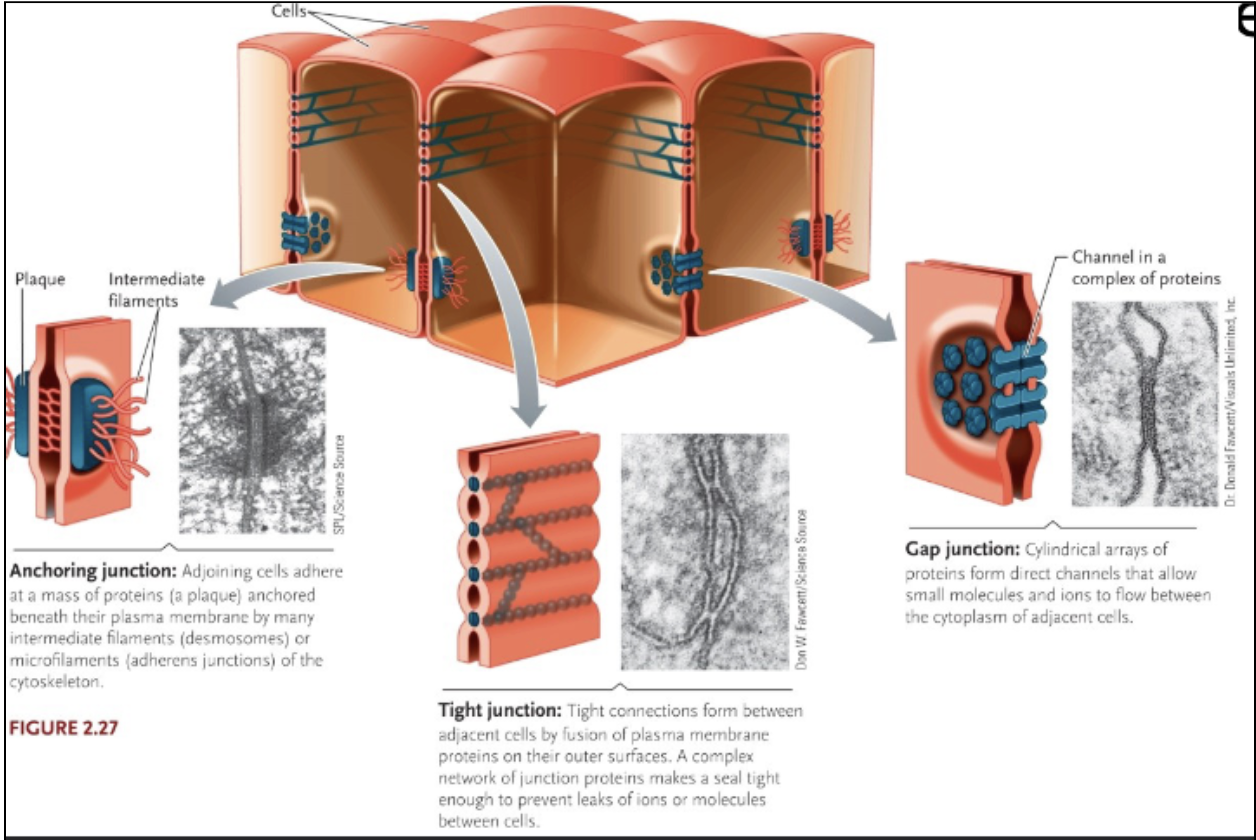
Tissues (3)
Group of similar cells & extracellular substances working together to carry out specific function for the organism as a whole
Requires that cells attach to one another & communicate with one another
Both plants & animals are organized at the tissue level
Tissues in Animals (2)
In triploblasts, four types of tissues, arising from three embryonic germ layers
The organs of multicellular organisms are composed of basic tissue types, specialized in structure & functions to carry out different tasks for the organism as a whole
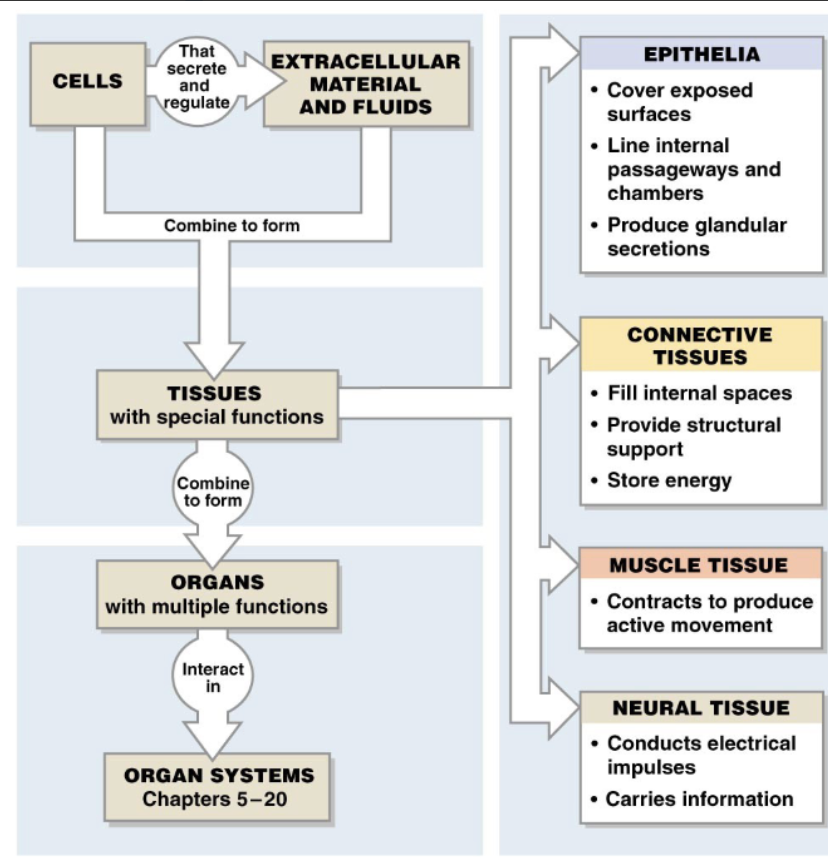
Extracellular Matrix & Cells
Characteristic of animals
Basic matrix is acellular, penetrated by network of collagen fibres
Varies greatly among different organisms and types of connective tissues
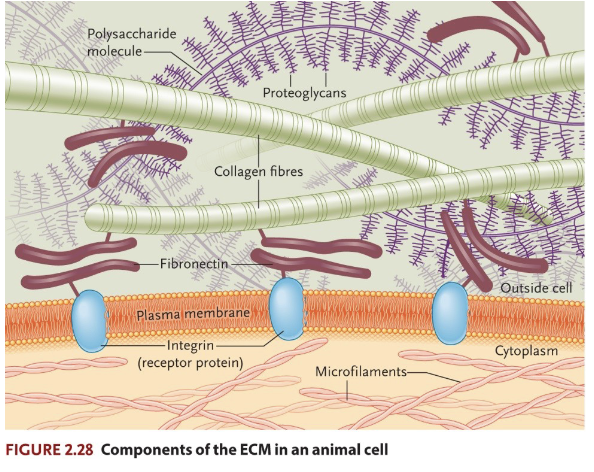
Collagen & Connective Tissues
Collagen is an extracellular fibrous protein found in connective tissues
Unique to animals
Collagen is the primary structural protein within connective tissues, providing strength, flexibility, and resilience
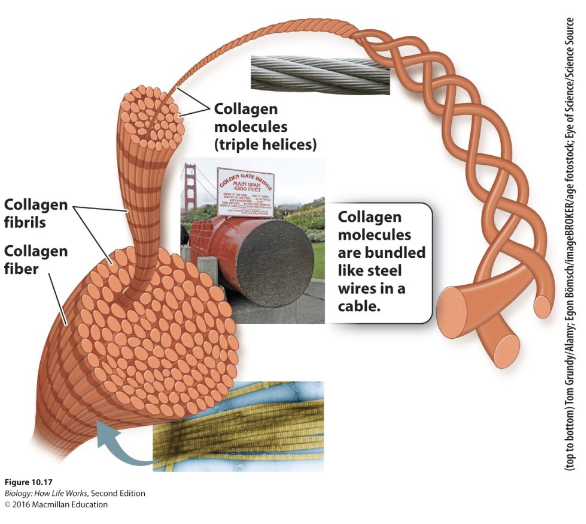
THEME 2: ANIMALS
Define Clades
Group of organisms with a unique common ancestor and sharing synapomorphies (shared derived characters/homologies)
Can be more or less inclusive
Clade: Opisthokonts (Composed of (3))
1) Choanoflagellates
2) Animals
3) Fungi
Define Opisthokonts (3)
Opisthios - Single, posterior
Kontos - Flagellum
Opisthokonts are characterized by the single, posterior flagellum and flattened cristae in mitochondria (but variable)
Choanoflagellates: Characteristics (3)
1) Unicellular opisthokont eukaryotes
2) Sessile
3) Reproduce asexually
What is the closest clade to animalia among opisthokonts?
Choanoflagellates
“Collar” around flagellum in choanoflagellates consists of ___
Contractile microfibrils
Define filter feeding in choanoflagellates
Currents set up by flagellar action carry food particles into collar, trapped and carried down to cell
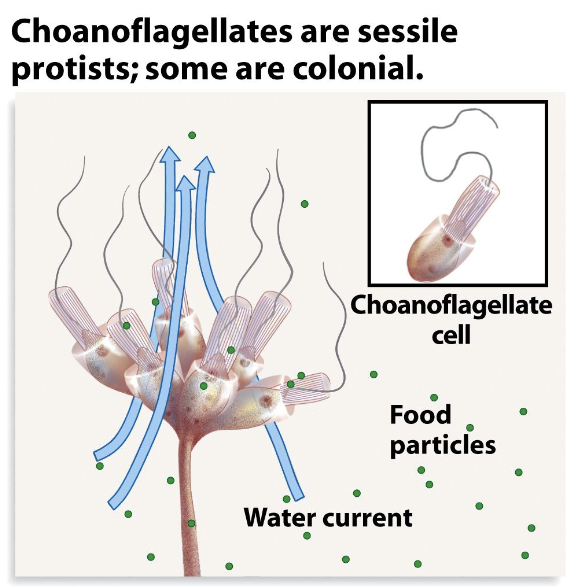
What is the theory for the origins of animals (opisthokonts)?
Ancestral animal was descended from a colonial choanoflagellate
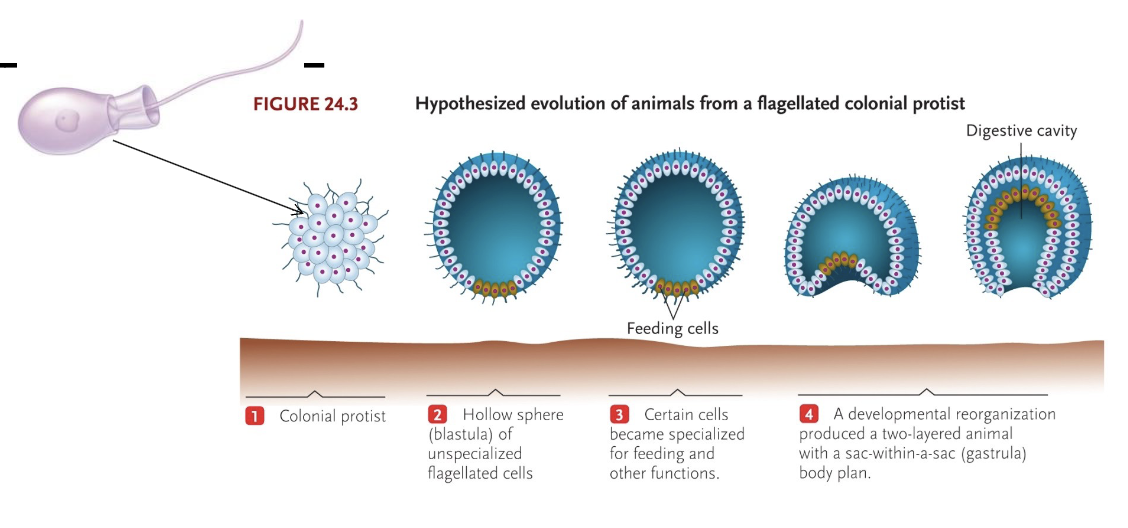
Animals: Characteristics (9)
1) Multicellular eukaryote
2) Chemoheterotrophic
3) Extracellular digestion
4) Cell membranes contact adjacent cell membranes (no cell walls)
5) Motile (self-directed movement)
6) Oxidative phosphorylation to supply ATP
7) Sense and respond to the environment rapidly
8) Sexual reproduction featuring eggs and sperm (single cells)
9) Diploid stage is dominant (usually), haploid is short-lived
4 diagnostic characteristics only found in animals
1) Develop from a blastula and undergo gastrulation
2) Cell membranes contain cholesterol
3) Certain extracellular matrix molecules (e.g. the proteoglycan collagen)
4) Certain cell-cell membrane junctions
Tight/septate junctions
Anchoring junctions
Gap junctions
Archaeplastida: Plants (Characteristics (5))
1) Multicellular eukaryotes
2) Photoautotrophic (mostly)
Fix inorganic carbon using light energy
3) Cell walls
Cell membranes are not in contact
4) Sessile
5) Alternation of generations life cycle
Haploid (gametophyte) stage alternates with diploid (sporophyte) stage
Both are prominent/multicellular
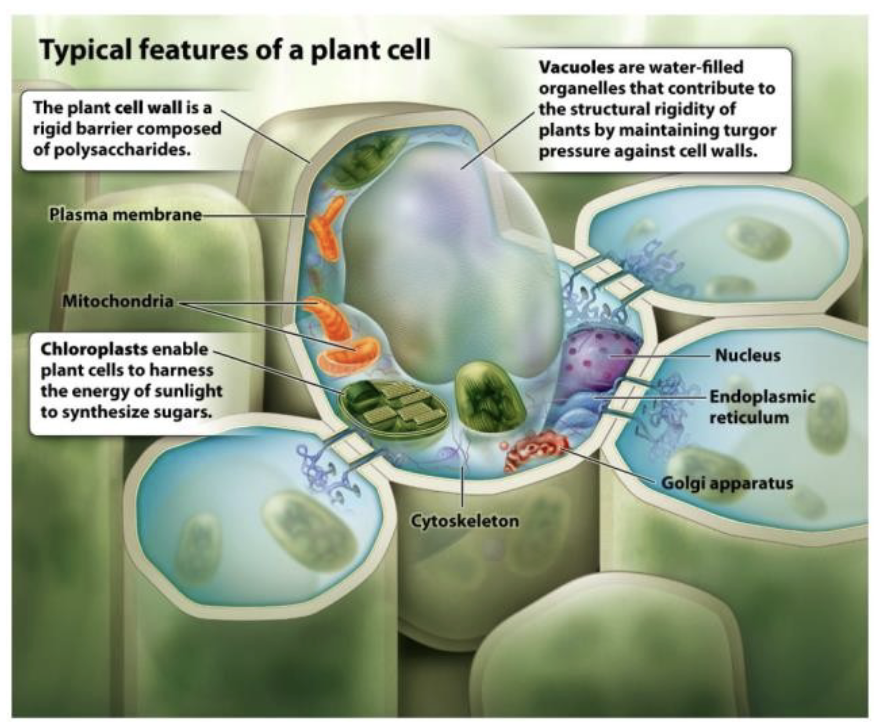
Cell Structures in Plant Cells (3)
1) Cell wall
Maintains cell shape
Protects cell
2) Large vacuole
Part of endomembrane system
Produces turgor against cell wall
3) Chloroplast
Fixation of inorganic carbon
Plants can “move” in 4 ways
1) Grow (up/down/laterally)
2) Phototropic
3) Move in response to physical stimuli
4) Disperse by pollen/seeds
Necessary correlates of requiring motility (can move themselves) (8)
1) Muscle
2) Well developed senses & cephalization (concentrated sensory and neural organs in an anterior head - looking forward)
3) Nervous system
4) Digestive system
5) Excretory system
6) Skeletal system
7) Locomotory organs
8) High metabolic rate (requires bulk flow & gas exchange systems)
___ is the science of classification of the living world
Systematics
Define Shared Derived Characters (Homology) (3)
Character (morphological, behavioral, molecular) found in all members of a group of species, that is derived from a character found in the common ancestor of that group of species
How useful homologies are in determining phylogeny depends upon how widely they are shared
We must be careful to avoid using characters that are similar in different organisms, but were not derived from a common ancestor (convergent evolution)
The likeliest phylogeny is the one requiring the ___ in a character
least amount of proposed evolutionary change
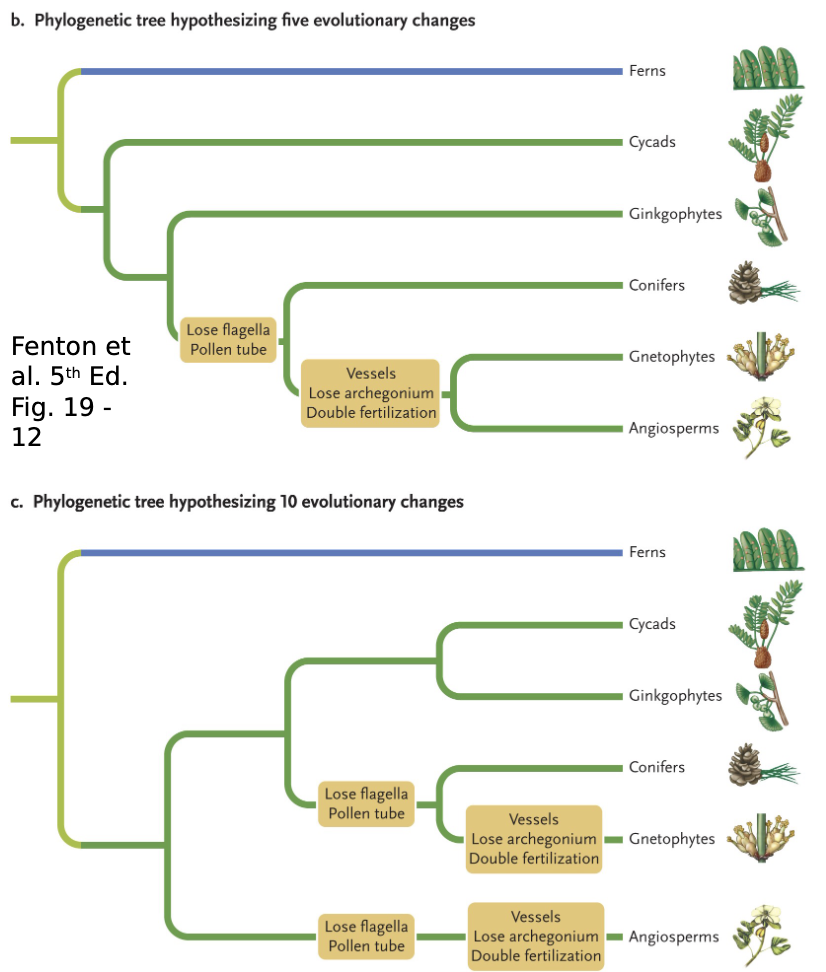
In cladistic classification, we want to identify ___
monophyletic taxa (clades)
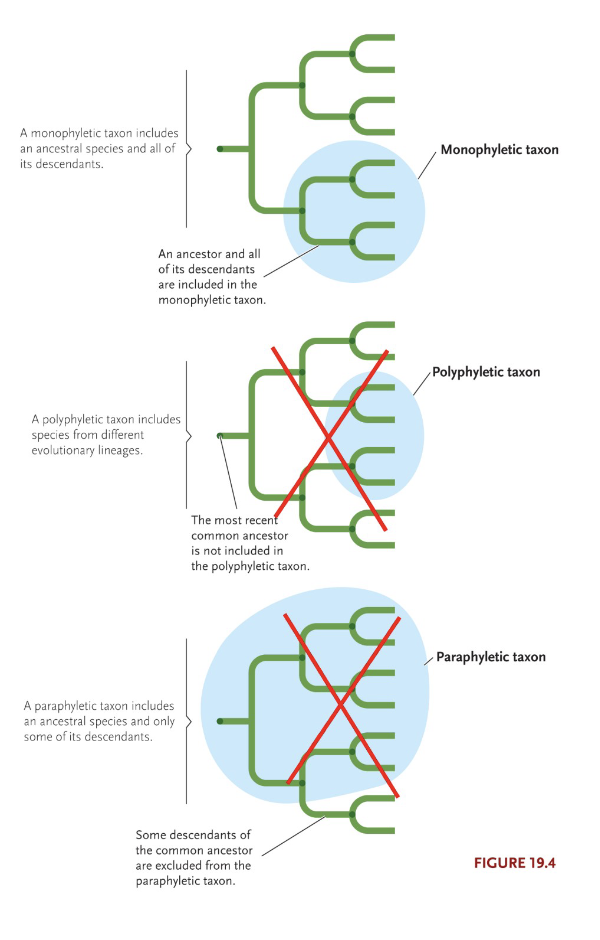
Ediacaran Fauna
635-541 MYA
Uncertain affinities (some may have been identified as animals because cholesterol has been isolated from their fossils
Cambrian Explosion
Burgess Shale Fauna: 525 - 515 MYA
First diverse fauna of large complex multicellular animals
First recognizable representatives of most modern animal phyla
First fauna with eyes & jaws
First fauna with largely bilaterian component
Homeotic Genes (4)
Genes specifying the development of specific structures at particular locations during embryogenesis
Responsible for symmetry, anterio-posterior, and dorso-ventral axes
Appear to be strongly conserved among animalia
Hox genes are a special class of homeotic genes
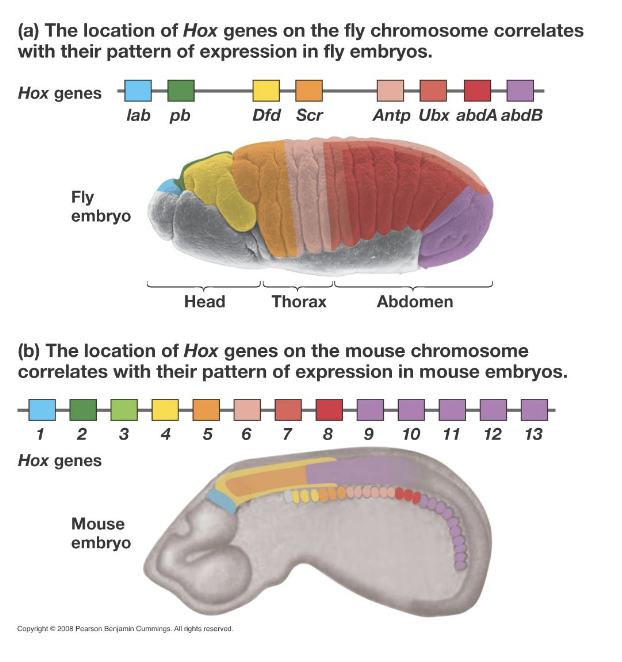
Changes in ___ and ___ may have enabled rapid diversification of body forms
Homeotic genes
Gene regulation
Cambrian explosion represents ___ in animalia
evolutionary radiation
Rapid increase (high rate of speciation) in the diversity of one clade
Animal Classification: Phyla
An animal phylum is a major monophyletic group originally distinguished by a unique basic body plan

Define The 3 Major Symmetries of Animal Classification
Asymmetric: No major axis of symmetry (e.g. sponges)
Radial Symmetry: Body can be cut into identical pie segments; no right/left, anterior/posterior (e.g. jellyfish sea anemones, starfish, sea urchins)
Bilateral Symmetry: Body has mirror-image; left-right symmetry
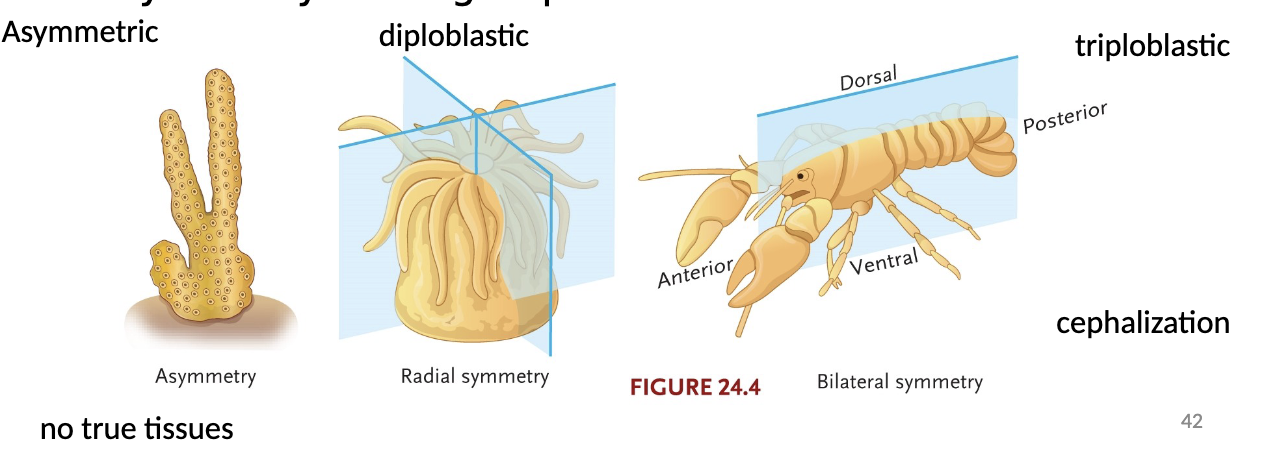
Define The 2 Major Developmental Patterns of Animal Classification
Diploblastic: Two embryonic tissue layers, endoderm & ectoderm
Triploblastic: Three embryonic tissue layers, endoderm, mesoderm, & ectoderm
Define The 3 Major Body Cavities (coelom) of Bilateria
Acoelomate: No cavity enclosing the gut
Pseudocoelomate: Cavity enclosing the gut lined with mesoderm on outer side
Coelomate: Gut suspended in cavity lined with mesoderm on both sides
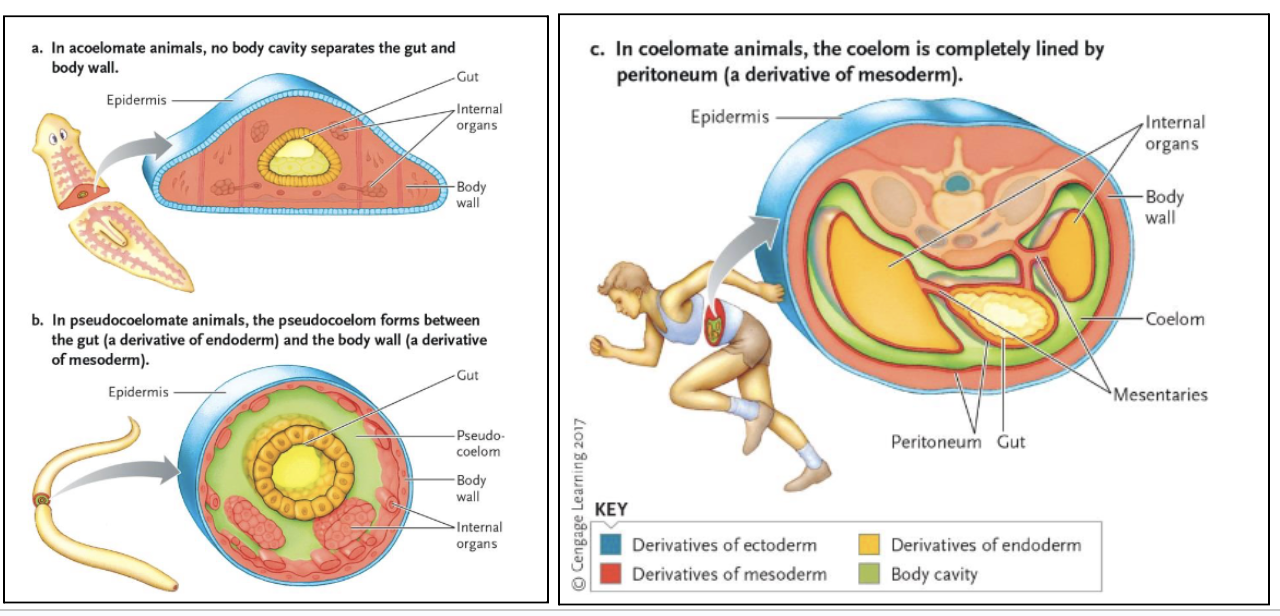
Two Divisions of Bilaterians
1) Protostomes
2) Deuterostomes
Both triploblastic
Protostomes (3)
1) Spiral cleavage
2) Schizocoely
Type of coelom formation that occurs during embryonic development, where the coelom forms by the splitting of the mesodermal tissue
3) Mouth derived from blastopore

Deuterostomes (3)
1) Radial cleavage
2) Enterocoely
Mesoderm is formed in a developing embryo in which the coelom forms from pouches pinched off of the digestive tract
3) Anus derived from blastopore
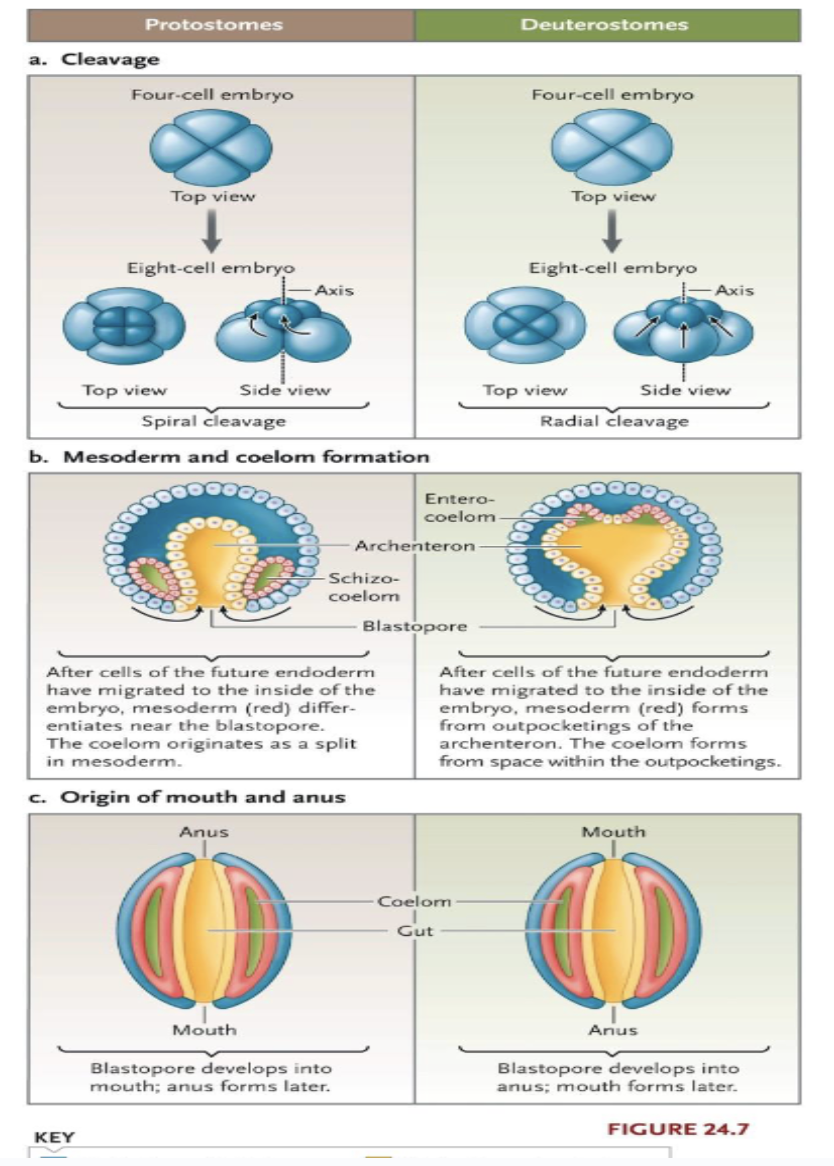
Another morphological character used in animal classification is ___
Body segmentation
Metameric Segmentation
Repeating
Occurs in both protostomes & deuterostomes (chordates, arthropods, annelids)
Dorsoventral orientation of central nervous system & the main elements of circulatory system
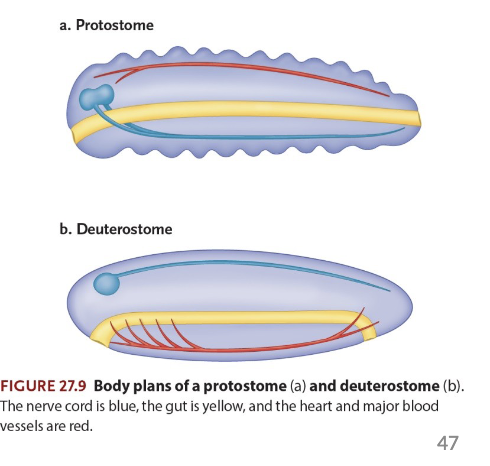
__ & ___ are now the primary source of information about phylogenies
DNA
Proteins
Phylum Ctenophora: The Comb Jellies (3)
Diploblastic - biradial symmetry
Sister group to all other animals (possibly)
“Combs” are rows of fused cilia that are used in locomotion
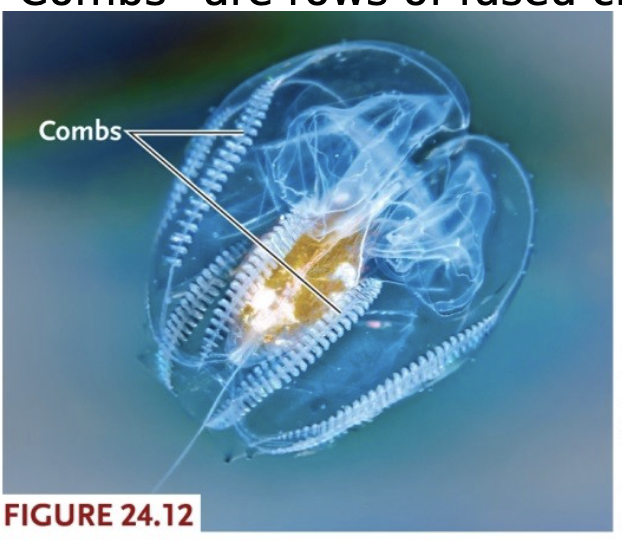
Phylum Porifera (Sponges) (5)
Assymetrical
Parazoans (no true tissues) neither diploblasts or triploblasts
Sessile as adults
Choanocytes (very similar to choanoflagellates) coordinated flagellar action produces inward water currents
Suspension Feeders: Choanocytes filter food particles out of water
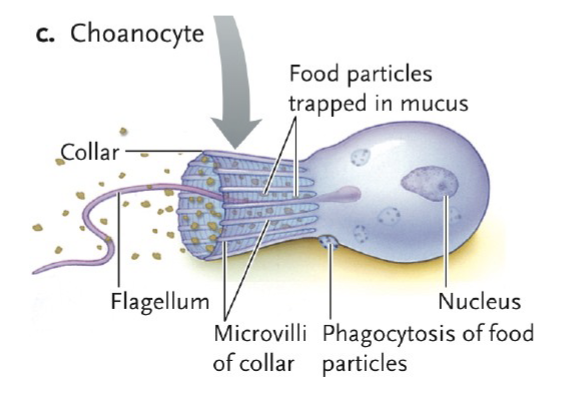
Phylum Cnidaria (3)
Radial symmetry (diploblastic)
Jellyfish, sea anemones, coral hydra
Life cycles generally incorporate both polyp & medusa stages
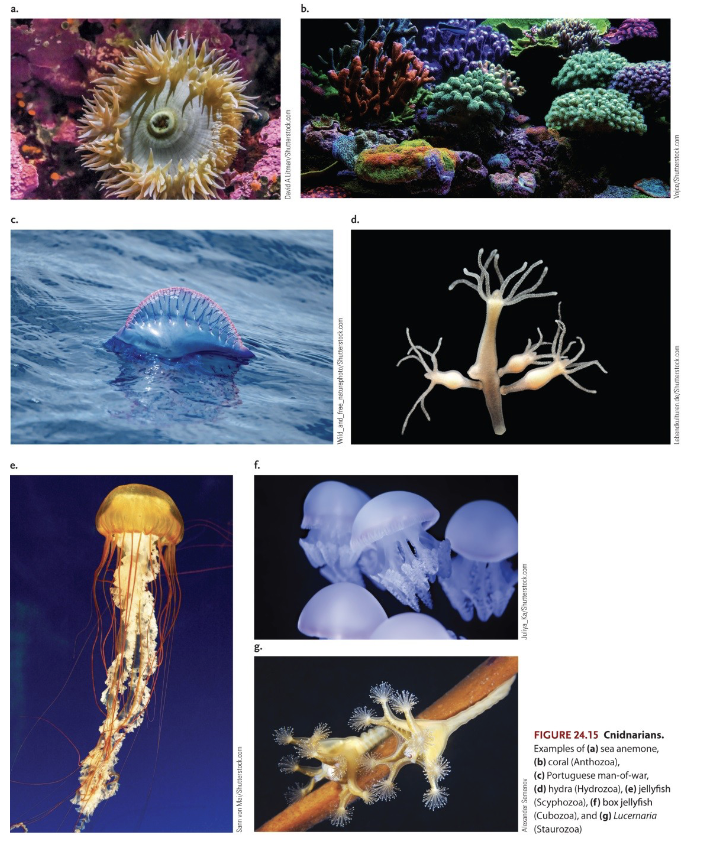
Polyp & Medusa Stages
Sessile formations are called polyps, whilst swimming forms are referred to as medusa. The difference between polyp and medusa is that polyp is a fixed, cylindrical structure that symbolizes the asexual stage. Medusa is a free-swimming, umbrella-like structure representing the sexual stage.
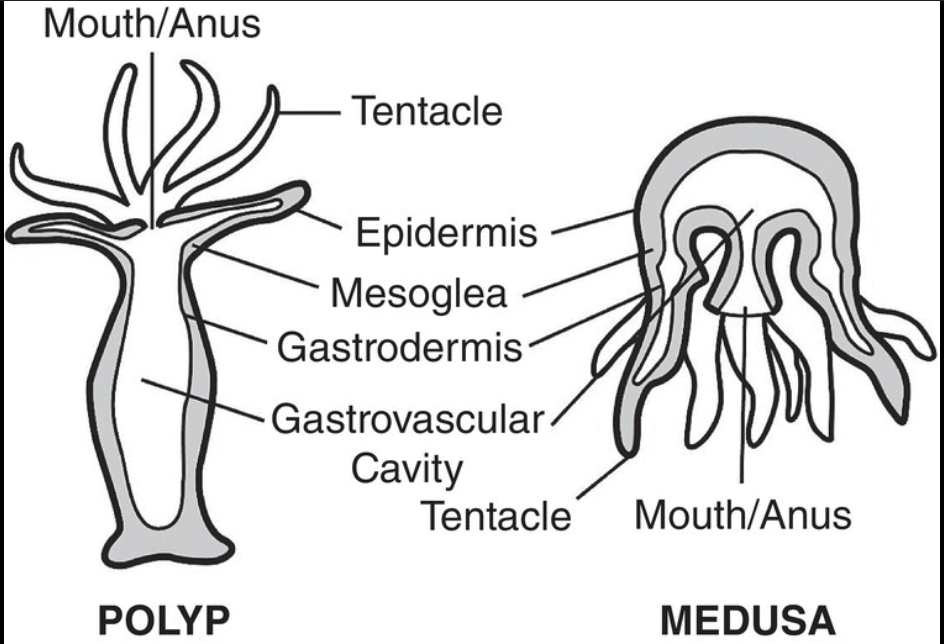
Cnidocytes & Nematocysts (2) + Definitions
Shared derived character of Cnidaria
Used to capture prey
Cnidocytes: Specialized cells that contain the stinging organelles located on the tentacles and other parts of cnidarians. Activated by touch or chemical signals, and when triggered release nematocysts to deliver a sting.
Nematocysts: Stinging organelles within cnidocytes that upon activation eject rapidly, penetrating the target and often releasing toxins to immobilize or harm the prey or predator.
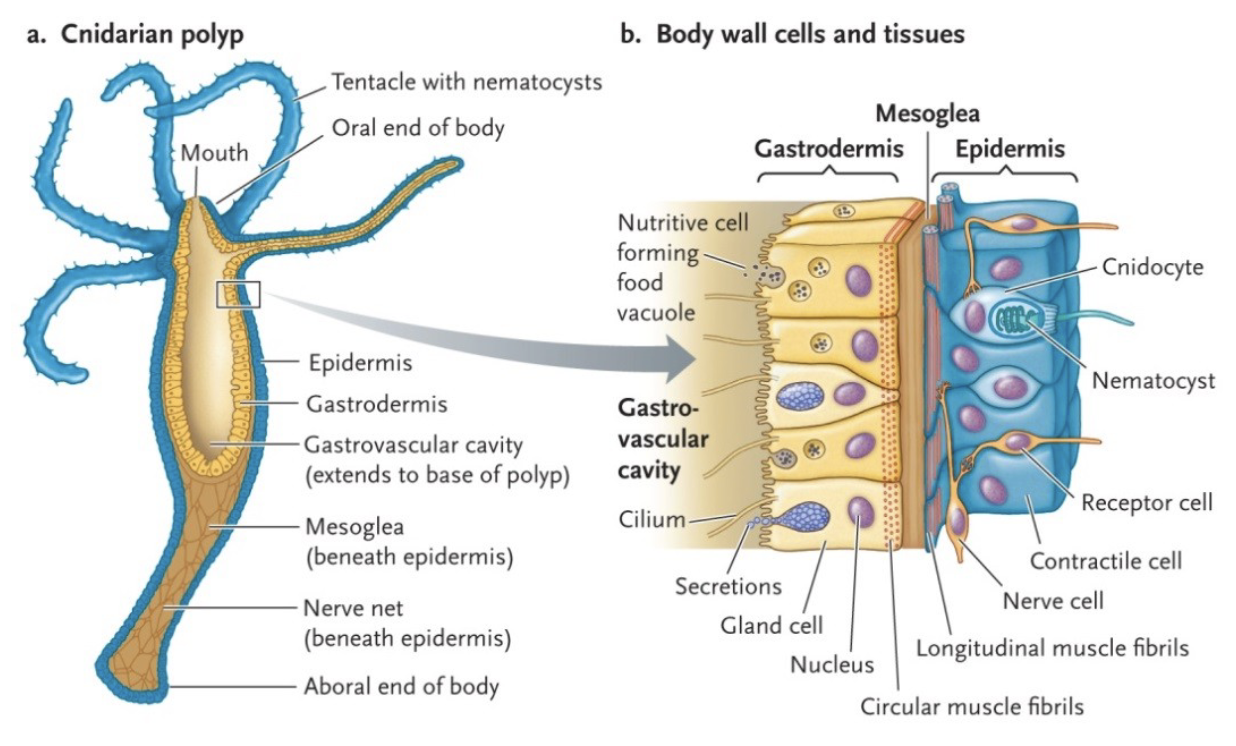
Colonial Cnidarians (2)
Species within the phylum cnidaria that live in colonies, where individual organisms (polyps) are physically connected and function together as a single entity
1) Siphonophores
Colonial cnidarians composed of several different types of individuals, modified for different functions
2) Corals
Colonial cnidarians that build calcareous or proteinaceous skeletons
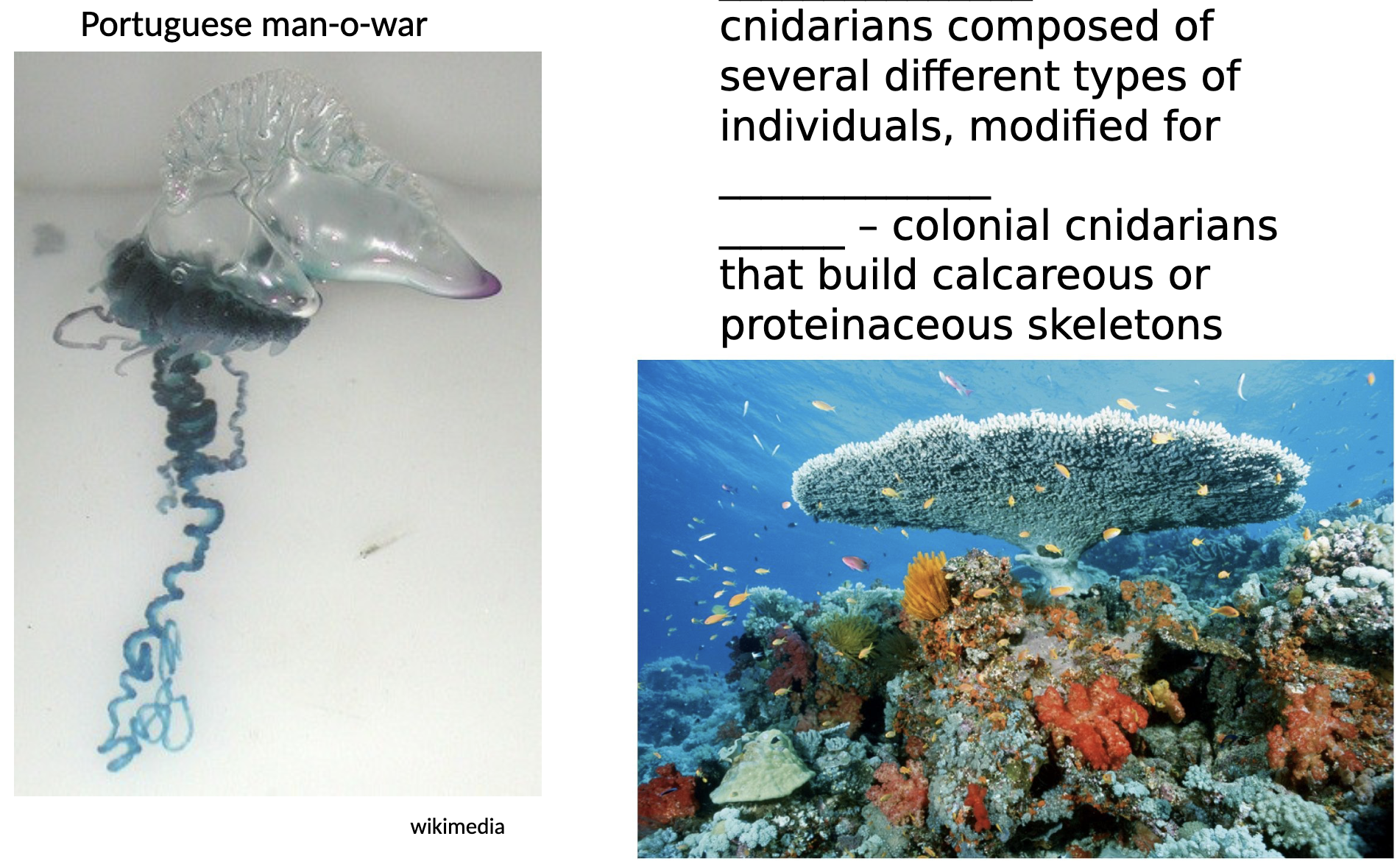
Protostomes are divided into: (2)
1) Lophotrochozoans
Some phyla have a “trochophore” larva (a type of free-swimming, planktonic larval stage with bands of cilia)
Some phyla have a lophophore feeding structure (a crown of ciliated tentacles around the mouth, used for feeding)
2) Ecdysozoans
Growth is through ecdysis of the cuticle or exoskeleton (acellular - secreted by epidermal cells)
Ecdysis: Moulting/shedding of the cuticle/exoskeleton
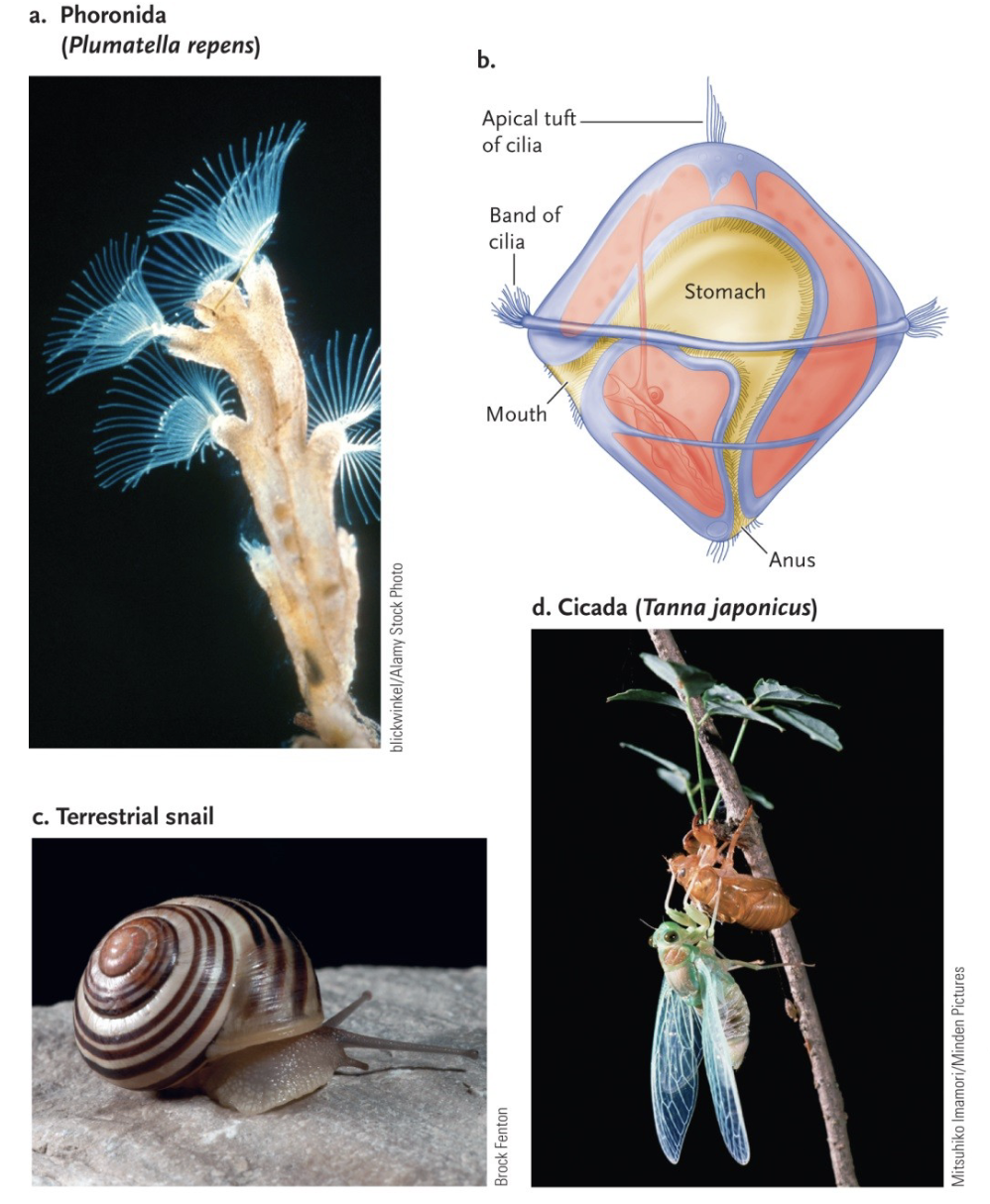
Lophotrochozoans: Phylum Platyhelminthes (3)
Acoelomate (no cavity between the body wall and gut)
Parasites and predators
Gut has only one opening (acts as both mouth & anus)
Example: Flatworm
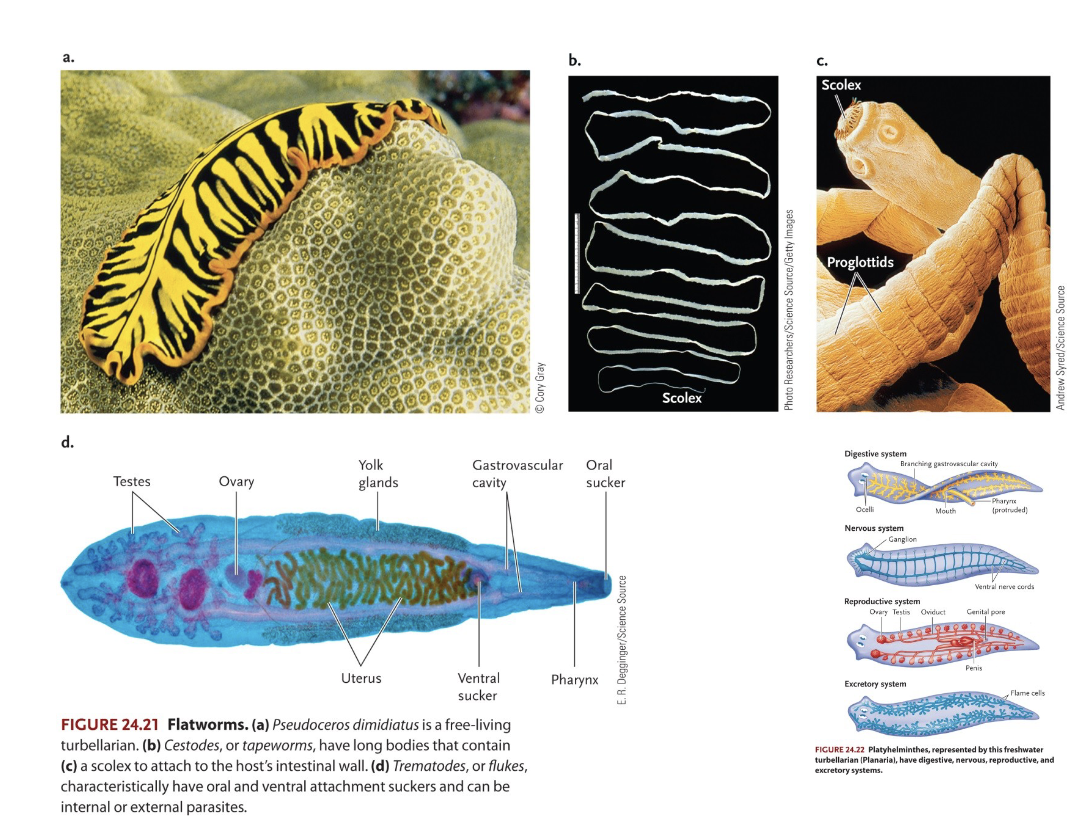
Lophotrochozoans: Phylum Mollusca (5)
100,000 species
1mm to over 18m
Body organized into foot, mantle, visceral mass
Unsegmented (but some evidence of earlier segmentation)
Considerable morphological variation among major groups

Lophotrochozoans: Phylum Annelida (2)
Metameric Segmentation
Coelomate
